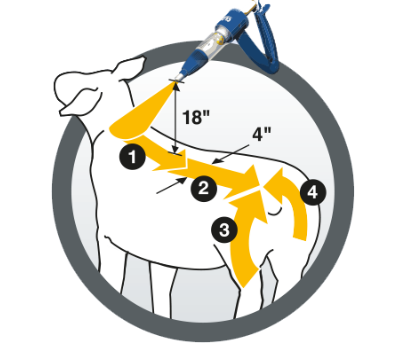Now is an ideal opportunity to remind ourselves of some of the important details relating to blowfly biology and the treatment options available to us.
Blowfly strike affects up to 80% of flocks¹ throughout the Republic of Ireland and the UK each year and is a significant economic and welfare problem.
These economic costs include mortality, decreased productivity, hide and wool damage, treatment and control costs, and associated costs of frequent flock inspections².
All of these can have a big impact on profitability when rearing sheep.
With the lengthening fly season due to the change in climate, it’s imperative that advisors and vets continue to look at preventing fly strike in a proactive manner.
The severe negative welfare implications that fly strike can cause in sheep should be borne in mind as well as the considerable burden it places on farmers from a financial, emotional and stress perspective.
A concise review of the causes of blowfly strike, the fly life cycle, control and treatment options are included here.
Blowfly strike
Strike is caused by the blowfly Lucilia sericata often referred to as the green bottle fly.
Other secondary fly species, predominantly Lucilia caesar, Protophormia terraenovae and Wohlfahrtia magnifica, may also be present in certain areas².
- Sheep susceptibility – wool length and quality.
- Warm and humid conditions – larvae commence feeding following egg laying by active female flies.
- Rainfall – facilitates damp and humid fleece conditions on susceptible sheep which attracts flies.
- Increased faecal soiling – crutching, dagging and proper worm control are important to minimise this.
- Tail docking – strike incidence is increased in undocked lambs³.
- Damaged skin – wounds and foot rot.
- Carcasses on-farm – provide feeding material for flies.
Fly strike usually appears as a discoloured and moist area of wool. Closer examination reveals maggots alongside a foul-smelling odour.
Affected animals are often restless, dull and reluctant to graze. These sheep kick and focus on the stricken area.
Prompt diagnosis and treatment is essential and a plan should be put in place to protect the rest of the flock if not already undertaken.
Experienced sheep farmers may recognise these signs more easily than smallholders or those new to sheep rearing.
Climate
As we see in other diseases, climate also has a crucial role to play in blowfly biology. Climate influences many of the risk factors previously mentioned in facilitating high numbers of flies during the season.
Changing climatic conditions are likely to extend the blowfly season with earlier emergence possible in the spring².
This is worth considering as it will impact greatly on the advice given to farmers in terms of choosing preventative approaches and treatments.
Online initiatives, which facilitate the prompt reporting of strike, are useful in monitoring strike and for providing farmers with local disease information.
At this point it seems appropriate to remind ourselves of the life cycle and characteristics of blowfly strike in sheep.
The female fly lays batches of 200-300 eggs over a period of three-to-four weeks. Eggs then hatch in favourable conditions within a few hours to first-stage larvae.
These larvae then begin to develop through two further stages. Second and third-stage larvae have mouthparts which damage the skin as they feed. This results in strike and the signs we observe in affected animals.
The strong odour emitted by the larvae infestation attracts other flies to lay eggs.
The third-stage larvae drop off into the soil in as little as three days to pupate and metamorphose into adults. This can occur in under a week in favourable summer conditions.
The blowfly larvae need soil temperatures above 9°C to develop. The first ‘wave’ of flies from overwintered larvae results in spring strike once these soil conditions are met.
Most strikes occur in the anal-perineum area (breech), but strike can also affect other areas such as the neck, shoulders, back, withers and feet. This is worth considering during careful examination of the affected sheep.
Care should also be taken when tagging sheep to minimise the risk of flystrike.
Control options
Flystrike control through mechanical and chemical methods is a component of the 2017 Sheep Welfare Scheme run by the Department of Agriculture (DAFM).
It also encourages dagging of sheep to reduce the risk of breech strike⁴.
Regular monitoring of flocks for flystrike throughout the season is required and at least daily inspection of flocks is needed as laid down in EU legislation⁵.
In respect to chemical control methods, the use of narrow spectrum preventative products is encouraged. These targeted blowfly products greatly reduce the risk of strike and offer the longest-lasting protection over the course of the season when flies are active.
By treating early, the number of blowflies will be reduced which, in turn, will reduce the number for the remainder of the season.
IGRs interfere with cuticle formation and chitin synthesis and, thus, disrupt the larval moulting process (see diagram 1) and prevent the larvae from completing their life cycle.
However, these products will not treat existing strike and prompt treatment with an appropriate product such as Young’s Vector Pour-On (marketed as Crovect Pour-On in Northern Ireland) is recommended.
Application
The correct application of the chosen product to prevent flystrike is critical.
Unfortunately in many cases where poor efficacy is suspected, it’s often as a consequence of incorrect application of the chosen product or not adhering to the manufacturer’s instructions in terms of equipment choice, dose rates and technique.
Applying the products correctly as per the label recommendations can help to ensure that longer-lasting protection against flystrike is provided.
This is crucially important as it gives greater piece of mind to flock owners that their sheep are protected during the high-risk period of the warmer months of the year.
Farmers are busy with other tasks during these months, so the correct use and application of the chosen product will save them time and hassle in the long run while also optimising sheep welfare.
Reminding farmers of the correct application technique is worthwhile at the point of purchase to ensure greater compliance.
The Clik range of products should be applied using the ‘four-stroke’ method where four separate bands of the product are applied as illustrated below (diagram 2).
Sheep must be dagged appropriately prior to the application of any pour-on product to ensure that the product works more effectively.
Consideration should also be given as to whether anthelminthics are required if sheep are found to have faecal soiling on their breech areas from the impact of gastrointestinal parasites.
Other causes of faecal soiling around the breech should also be considered such as nutrition. Veterinary advice should be sought if required.
Treatment
Many cases of flystrike can be treated by the farmer themselves using appropriate products such as Young’s Vector Pour-On (marketed as Crovect Pour-On in Northern Ireland).
A thorough examination of the entire fleece and animal should be carried out to determine the location of all the affected areas.
Care should be taken to check the feet as foot rot lesions can cause strike. This can occur despite the use of preventative products.
Affected areas should be clipped and a 5cm margin of healthy skin should be observed to ensure all maggot trails are identified. The affected areas should be hygienically cleaned and all maggots removed.
Maggots ideally should be placed in a sealed plastic bag to reduce the potential for adult fly formation from these maggots.
Supportive treatment in terms of fluids, pain relief and antibiotics may be required. Humane euthanasia may be required in some cases where the prognosis is poor.
Care should be taken to ensure all carcasses are removed from the farm as these provide ideal conditions for blowflies and other flies to feed on.
A proactive and preventative approach should be encouraged as much as possible, while also highlighting the importance of climate, flock monitoring and correct use of products to prevent blowfly strike in your farmer’s sheep.
Blowfly monitoring map
AgriLand and Elanco are running a blowfly outbreak monitoring campaign across Ireland. Check out the interactive map below to see if your region has been affected.
Submit a report if you’ve been affected to be in with a chance to win a brand new iPad.
Click here to launch the Blowfly monitoring map
References:
- www.scops.org.uk
- Wall, R. and Lovatt, F. (2015). Blowfly strike: biology, epidemiology and control. In Practice, 37(4), 181-188.
- French, N. P., Wall , R. & Morgan, K. L. (1994) Lamb tail docking: a controlled field study of the effects of tail amputation on health and productivity. Veterinary Record 134, 463-467.
- Department Of Agriculture Sheep Welfare
- Department of Agriculture Cross Compliance



